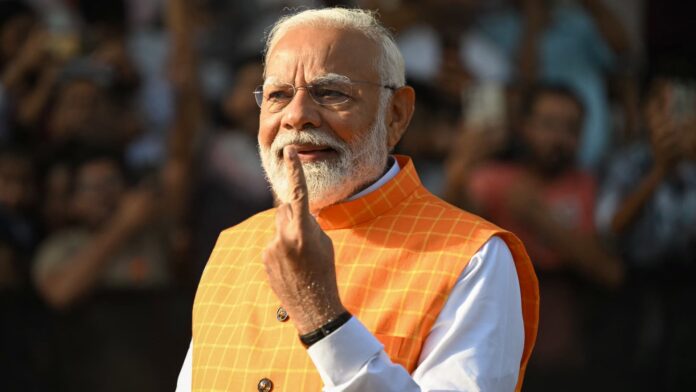India’s Prime Minister Narendra Modi displays his inked marked finger after casting his ballot at a polling booth at Ranip, Ahmedabad on May 7, 2024.Â
Sajjad Hussain | Afp | Getty Images
The Bharatiya Janata Party-led National Democratic Alliance is set to come to power in India again â albeit with a much reduced majority, according to the latest data from the Election Commission of India.
The BJP-led NDA was ahead on nearly 290 parliamentary seats, while the opposition Indian National Developmental Inclusive Alliance (INDIA), led by the Indian National Congress was leading on 230 seats, according to local media.
The BJP-led National Democratic Alliance won 353 seats in 2019. If the numbers hold, the BJP would lose about 60 seat compared with its 2019 general election tally of 303.
The lower house of India’s parliament has 543 seats, and the party or coalition that wins at least 272 forms the government.Â
“People are so eager in India to see Minister Modi take the reins once more. And I think the pressure is on him more than ever,” said Samir Kapadia, CEO of India Index and managing principal at Vogel Group. “He’ll continue to build India in a way that that Indians want to see.”
Modi reportedly said in March that he was confident of the BJP-led NDA securing over 400 seats.
“As much as Prime Minister Modi remains a popular figure, the shine has worn off as the everyday lived realities of unemployment, inflation and governance are dominating voters minds,” Yamini Aiyar, former president of the New Delhi-based Centre for Policy Research told CNBC’s “Street Signs Asia.”
According to an April survey conducted by the Centre for the Study of Developing Societies, unemployment was the top concern for 27% of the 10,000 people surveyed. More than half (62%) of the respondents said it had become more difficult to find a job in the last five years during Modi’s second term.
Unemployment rate in the world’s most populous country rose to 8.1% in April compared to 7.4% in March, according to the Centre for Monitoring Indian Economy.
“It remains to be seen whether Modi can attract the kind of labor intensive jobs that are needed by India in today,” said Atman Trivedi, partner and lead of South Asia practice at Albright Stonebridge Group.
India’s benchmark indexes Nifty 50 and the BSE Sensex plunged 8% as trends showed the BJP might fall short of a clear majority on its own.
Market heavyweights Adani Ports and Adani Enterprises had both plunged by more than 20%, while State Bank of India and ICICI Bank fell 17% and almost 9% respectively.
On Monday, both the Nifty and Sensex had hit record level highs and logged their best intraday gains since Feb. 1, 2021, gaining 3.25% and 3.39%, respectively, after exit polls over the weekend predicted a thumping majority for Modi’s BJP.
The Indian rupee weakened 0.31% on Tuesday after strengthening 0.41% on Monday.
Modi’s decade-long rule
Under Modi, India, home to 1.4 billion people, has witnessed robust economic growth. The fastest growing economy in the world saw its GDP expand by 8.2% in fiscal year 2024.
The International Monetary Fund projects that India’s economy will grow 6.8% in 2024 and 6.5% in 2025, compared with China’s growth outlook of 4.6% in 2024 and 4.1% in 2025.
“PM Modi will have to flex his muscles against adversaries like China. That will involve signaling support for indigenous defense manufacturing capabilities,” Kapadia highlighted.
In the BJP’s manifesto for the upcoming term, Modi said that the government would make India one of the the world’s top three economies, aggressively fight poverty, open up new avenues for growth and fight corruption.Â
“We have gone from a nation that was in the ‘Fragile Five’ to a nation that is one of the top five economies of the world,” he said in the manifesto.Â
While India has seen robust economic growth under Modi, observers and critics have warned about the country’s ‘democratic decline.’Â
“The ruling anti-pluralist, Hindu-nationalist Bharatiya Janata Party (BJP) with Prime Minister Modi at the helm has for example used laws on sedition, defamation, and counterterrorism to silence critics,” Sweden-based V-Dem Institute said in a 2024 report.Â
Others, however, have pointed to the giant electoral exercise in the country as a testimony to its strong democratic fundamentals.
“The election also shines a light on India as a rising star that’s built on democracy, and I’m glad that it is bringing a lot of attention to all the dynamic growth that we’re seeing in the country right now,” said Malcom Dorson, senior portfolio manager and head of emerging markets strategy at Global X ETFs.
â CNBC’s Sumathi Bala contributed to this story.



